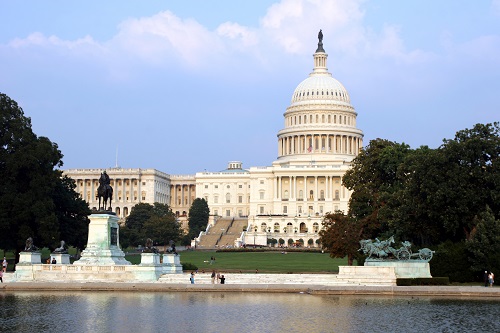Issue Briefs

After the Midterms: The Invisible Victory of the US Industrial Northeast
Martin Sieff
December 20, 2018
The outcome of the November 2018 midterm US Congressional elections was not the sweeping blue wave of Democratic triumph repudiating with national rage the policies of certainly controversial President Donald Trump: But almost un-noticed it confirmed the shock basic results of the 2016 presidential elections. The Democrats certainly regained control of the House of Representatives, though with a swing well within midterm norms, and not remotely a landslide by historic standards. And they failed by far to regain control of the Senate, leaving the Republicans in fact with a relatively narrow but far more workable majority in the Upper Chamber.
Trump controls the GOP
The elections ironically greatly strengthened Trump’s hold on the national Republican Party. Many of his loudest critics retired from both the Senate and the House. Republican candidates who supported him and whom he energetically campaigned for were more often than not triumphantly elected. Lukewarm party moderates who had conspicuously not supported Trump were deserted by the president’s base and more often than not went down to defeat.
A new political geography
Something very fundamental and strange has happened to the geography of American politics. It is so enormous, so obvious and so counter to the accepted wisdom of the past half century that the entire print and broadcast media have missed it completely. Texas, the West Coast and the Southwest are OUT and the old Industrial Northeast and New York City are back IN.
In national politics, in contrast to the generational revolution that is certainly transforming the Democratic Party in the House of Representatives, Youth is dead and Age sweeps all before it. In 2016, the Republican presidential nomination was won in a landslide weeks before the last batch of primaries were even contested by a 69-year old New York City billionaire.
New York is back
Donald Trump does not deny his New York identity. He revels in it. Two years into his presidency, still politically assaulted on every side, he has just set up a re-election campaign and has subordinated the Republican National Committee he ran against in 2016 to his own personal re-election organization.
Trump does not fake a “good ‘ol boy” persona like fake cowboy George W. Bush — the heir of a family of elite billionaires from New England — so ludicrously did in 2000 and 2004.
Trump does not fake a compassion or awareness of the lives of ordinary people as Mitt Romney — another billionaire and former hedge fund boss to boot — from New England did in 2012.
New York “values”
In his 2016 campaign, Trump defended “New York values” against the snide innuendoes of Senator Ted Cruz in a national Republican debate and in his knockout triumph over Cruz in the Indiana primary. By then Trump had routed Cruz across the South. Cruz only scraped meager victories in his home state of Texas, in Wisconsin and a couple of other places. But in the end, the Midwest too buried him.
Two years into his presidency, Trump risks a potentially disastrous trade war with China in order to revive the US domestic industrial economy. He is particularly obsessed with bringing back jobs in steelmaking and manufacturing. He focuses obsessively on the state economies of Ohio, Pennsylvania, Wisconsin and Michigan.
However, Trump is no outlier, the weird exception to some still, imagined functioning rule. The Democrats from coast-to-coast are looking to East Coast, New York City standard bearers too:
Hillary Clinton also a New Yorker
Hillary Clinton, daughter of Chicago, long ago brushed off her Arkansas veneer. She carpet-bagged her way to a twice –elected Senate seat from New York because she already was wealthy, elite, brash and bold New York in soul, as much as Trump.
Nor was Clinton the embodiment of Youth, quite the contrary: Had she been elected in 2016 as was almost universally expected, she would have been older on taking the oath of office than even Ronald Reagan was.
And who ran Clinton an astonishingly close, sustained impressive race for the Democratic presidential nomination from coast to coast and from the Rio Grande to the Canadian border? Why, it was 74-year-old Brooklyn-born, self-declared democratic socialist Bernie Sanders.
Bernie Sanders from the North East
And the latest straw poll among Democrats for Freedom (DFF), an important influential grassroots organization with more than a million members, was easily won by Sanders with 36 percent of the vote. Second came his contemporary in age, also from the Northeast, former Senator and Vice president Joe Biden from Delaware.
Younger hopefuls Senator Kamala Harris of California and failed Texas Senate candidate Beto O’Rourke were nowhere to be seen. Neither of them has shown any credible national strength outside tiny cores of intra-party activists.
Sanders has lived his life in Vermont and well expresses the quirky, individualistic, hard-grained personal heroism of his admirable little northeastern rural state. But he also proudly still wears his defining New York identity on his heart.
The reversal of a historic trend
This was not supposed to happen. No New Yorker has been elected president of the United States in 72 years, since a dying Franklin Roosevelt won his fourth national election – against in fact, New York Governor Thomas E. Dewey in 1944. Since then, every twice–elected president has come from the Midwest (Eisenhower from Kansas and Obama from Illinois), the Southwest (Clinton from Arkansas and both President George Bush’s from Texas or California. And Ronald Reagan, GOP icon, also came from California.
Since 1924, the Republicans have NEVER won the presidency without at least one of their two candidates coming from California (Hoover in 1928, Richard M. Nixon in 1952 and 1956, and in 1968 and 1972, Ronald Reagan in 1980 and 1984) or Texas (George Herbert Walker Bush in 1988, George W. Bush in 2000 and 2004).
Front runners are from the North East
Yet this time, the only Republican presumptive presidential candidate and runaway winner in the primaries coast-to-coast comes from New York. Such a thing has not happened since Thomas E. Dewey got skinned by Harry Truman in 1948. And no New York Republican has won the presidency since Theodore Roosevelt in 1904.
Republican primary voters never took seriously former Texas Governor Rick Perry and for that matter Cruz in 2016, and there was not a single credible Republican from California in sight. There still isn’t. At state and national levels, the Republican Party is now dead in California. Even Orange County now goes blue.
On the Democratic side, Hillary Clinton fought desperately to win the California primary in 2016, but rests her national challenge on the bedrock of her New York base.
Long term regional political realignment?
Today we see that the 2016 outcome was no flash in the pan. There is reason for this and it is rooted in the widest social and economic forces reshaping the United States.
Protectionism, the issues of tariffs and a serious engagement to revive domestic industry across the US Heartland in the end may succeed or fail: But it has certainly become a serious political enterprise with its most significant audience located in the North East.
The Republican Party has already been reshaped by Trump as a nationalist political force –with lightning speed. The old GOP image with its classic liberal free trade obsession grounded on free markets and zero government intervention, so well articulated by Ronald Reagan and his heirs, has gone the way of the Dodo and the Jurassic dinosaurs.
Now the Democratic Party too has started to change. Its old fossils, led by House Speaker Nancy Pelosi and the ineffable Hillary Clinton, still fantasize that they can hold back the tide. They have no conception that the forces of political evolution have already rendered them extinct.
 |
Martin Sieff is a Global Policy Institute Fellow. He is author of Cycles of Change (Amazon-Kindle, 2015), a study of the patterns of US politics from Thomas Jefferson to Barack Obama; and Gathering Storm: The Seventh Era of American History and the Coming Crises That Will Lead to It. |
The views and opinions expressed in this issue brief are those of the author.